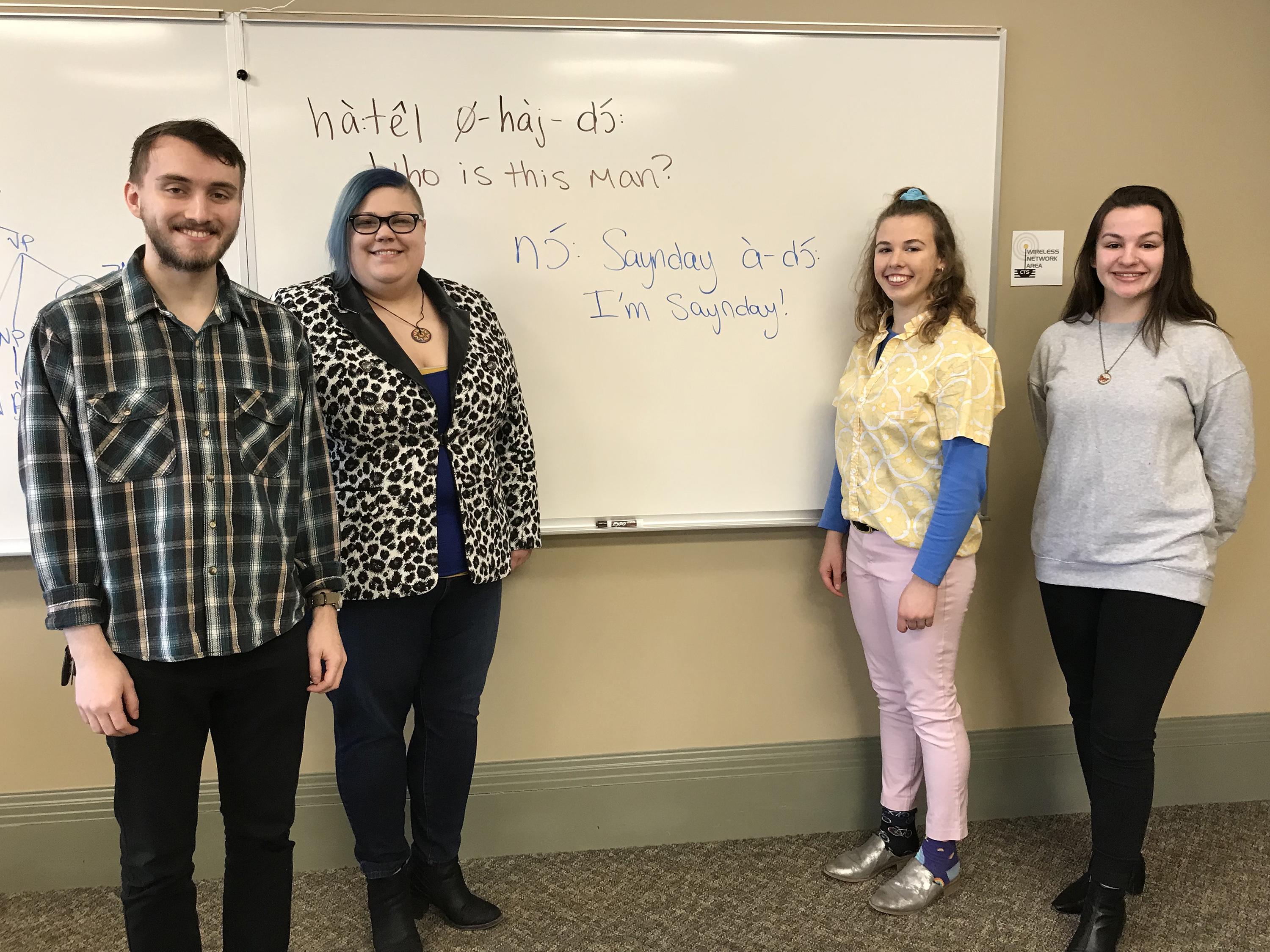Language preservation -- A faculty-student team will document an ongoing project to create a pilot dictionary to help preserve Kiowa, a Native American language with only 10 fluent speakers remaining. Showing some sample Kiowa phrases are, from left, student Ian White, linguistics faculty member Taylor Miller, and students Lillian Talmage and Autumn Schunk. Not present for the photo was Cory Becker-Warren, another student member of the research team.
A SUNY Oswego faculty-student team is trying to help preserve a Native American language, Kiowa, with only about 10 fluent speakers remaining.
Taylor Miller, a visiting assistant professor teaching linguistics, and students Cory Becker-Warren, Autumn Schunk, Lillian Talmage and Ian White will present “Documenting an Endangered Language: Making the First Kiowa Dictionary” at the college’s April 3 Quest celebration of scholarly and creative activities. Their presentation is part of a "Messy and Endangered Languages" session starting at 2 p.m. in 208 Marano Campus Center.
SUNY Oswego’s Endangered Languages Laboratory is part of a multi-site research project -- also including Kansas State University and the University of Oklahoma -- to create the first comprehensive dictionary for Kiowa. Miller started the process while a doctoral student at the University of Delaware, and saw the need for preserving Kiowa as urgent.
“There are only about 10 speakers of the language and they are all nearing 90 years old,” Miller explained. “The challenge is: How can we document this language as fast as possible in a way that their community actually wanted?”
The student researchers said they found attempting to preserve a language drew them to the project with great enthusiasm.
For White, a junior with a dual major in linguistics and cognitive science, this type of project “is exactly what I’ve always wanted to do,” he said. “My original goal going into linguistics was to work in language preservation in the field. I think it’s a very admirable project.”
White has led the transcription of audiotapes into English, an arduous process in itself. That the Kiowa language has no standard writing system and three different ways to spell some of the words makes it even more challenging, Miller notes.
Reviving a language
But the researchers are undaunted. Talmage, a sophomore who also has dual majors in linguistics and cognitive science, appreciated the opportunity to make a difference by keeping an important language from dying.
“So many languages die, and people don’t even realize it,” Talmage said. “This is the basis of linguistics; it’s real and it’s helping people.”
For Schunk, a freshman majoring in teaching English to speakers of other languages (TESOL), taking a class from Miller and learning about the project at the start of her college days was a thrilling opportunity.
“Being a TESOL major, I’m a language nerd,” Schunk said. “It was very new to me, but the thought of reviving a language really appealed to me and is something I wanted to invest my time in.”
Schunk, who grew up in the Buffalo area, has friends who are members of the Seneca Nation, and “I see how important their language and culture are to them,” she said.
Miller notes that while preservation is important from an academic and educational standpoint, it’s also crucial to honor what the remaining elders want done with their language and to make the project a true collaboration.
“For the Kiowa people, this language is very sacred and we have to treat it with respect,” Miller said. “This is a project the community asked for. You always have to remember the people behind what you’re trying to do.”
The pilot dictionary consists of words drawn from several children’s bedtime stories, mostly about the Kiowa trickster Saynday. In addition to the words themselves, the stories contain built-in lessons on the kinds of behaviors and values important to the culture.
“The students are working on taking what I’ve been doing and translating them into different writing systems so I can show people what it looks like,” Miller said.
The team is exploring funding to do field work and fresh interviews this summer in southwestern Oklahoma, where the remaining Kiowa speakers live.
The pilot dictionary the team will present at Quest also will be shared with Kiowa elders to give them something to examine right away to make sure the project is on the right track.
Once the elders confirm the work of their pilot dictionary, and the team can build on it, the plan is to launch the approved dictionary in fall. They would draw on the project to create educational resources that teachers on various levels can use in classrooms to convey the rich language and culture to new generations.
For more information on SUNY Oswego's Quest symposium, visit the Quest website.




